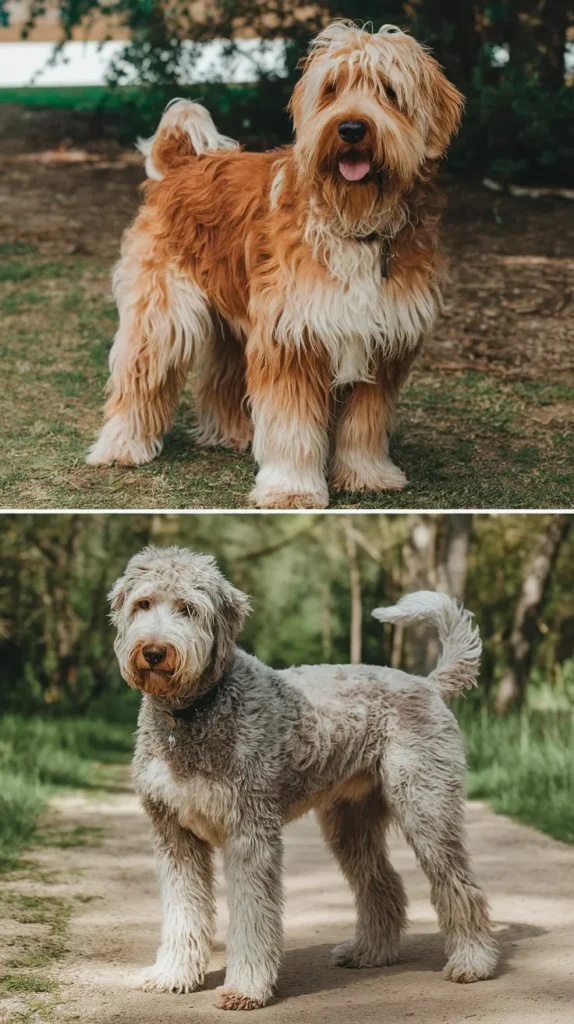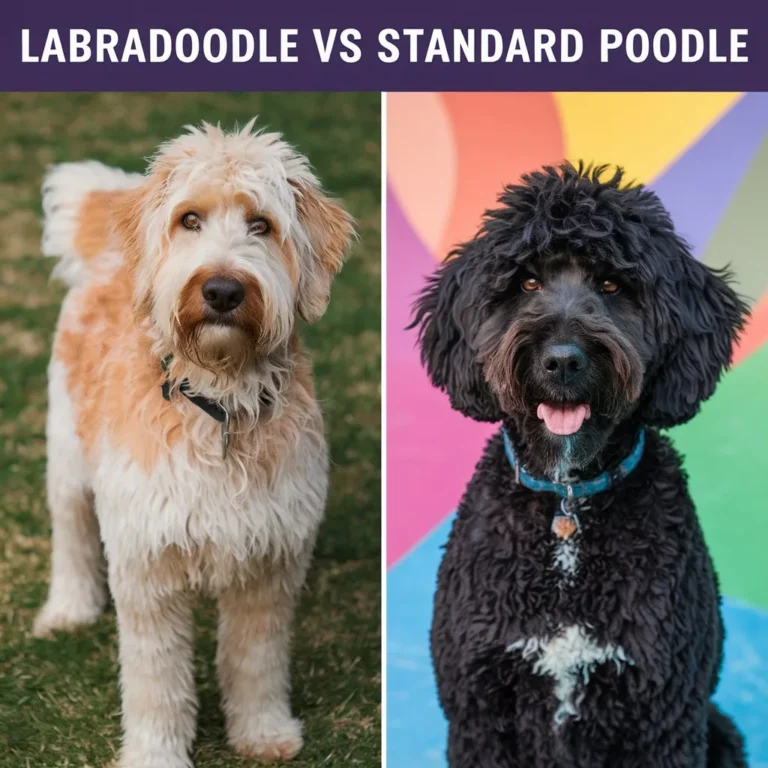Cobberdog Vs Labradoodle: Which Breed is Better for Families?
You’re contemplating bringing a new furry friend into your family, and you’ve narrowed it down to two popular breeds: the Cobberdog and the Labradoodle. Both are intelligent, social, and loyal, but which one is the best fit for you?
As you weigh their similarities and differences, you’ll want to ponder factors like grooming needs, exercise requirements, and temperament.
For instance, do you prefer a breed that thrives in a chaotic household or one that requires a structured routine? The choice ultimately depends on your lifestyle and needs, but which breed will win your heart?
In a Nutshell

- Cobberdogs and Labradoodles share similar temperament and personality traits, being highly social, intelligent, and anxious to please.
- Both breeds require regular grooming to prevent matting and tangling of their coats, with Cobberdogs having wavy or curly coats and Labradoodles having straight or wavy coats.
- They are prone to similar health issues, including hip dysplasia, eye problems, allergies, and obesity, and require regular veterinary check-ups and a balanced lifestyle.
- Both breeds need regular, structured exercise and training sessions, with daily walks and playtime activities necessary to help them burn off energy and stay healthy.
Origins of Cobberdogs and Labradoodles

Developed in the 1980s, both Cobberdogs and Labradoodles originated as crossbreeds between a Labrador Retriever and another breed, with the primary goal of creating a guide dog that combined the low-shedding trait of one parent breed with the high intelligence and trainability of the other.
You’ll find that their breeding history is rooted in the desire to create a dog that’s both intelligent and hypoallergenic.
The ancestral roots of Cobberdogs can be traced back to the Australian Labradoodle, which was initially bred by Wally Conron in the 1980s.
Conron, a breeder for the Royal Guide Dogs Association of Australia, aimed to create a dog that would be an excellent guide dog while also being suitable for people with allergies.
On the other hand, the Labradoodle’s breeding history is more varied, with multiple breeders contributing to its development.
Despite their differences, both breeds share a common goal: to provide a loyal companion that’s intelligent, trainable, and gentle.
Temperament and Personality Traits

Cobberdogs and Labradoodles share many desirable temperament and personality traits, such as being highly social, intelligent, and anxious to please.
Both breeds are known for their exceptional social skills, which make them perfect companions for families and individuals alike. They thrive on interaction and attention, and they’re quick to form strong bonds with their owners.
Some key characteristics of these breeds include:
- High energy levels, requiring regular exercise and mental stimulation
- Excellent trainability, thanks to their intelligence and desire to please
- Emotional maturity, allowing them to adapt to new situations and environments
As you consider bringing a Cobberdog or Labradoodle into your life, keep in mind that they require attention, exercise, and training to reach their full potential.
With the right care and attention, these breeds can become loving, loyal, and well-adjusted companions that bring joy and freedom to your life.
Grooming Needs and Maintenance

When it comes to their physical appearance, both Cobberdogs and Labradoodles require regular grooming to prevent matting and tangling of their coats, which can lead to skin irritation and other health issues. You’ll need to brush their coats regularly to prevent these problems.
Here’s a breakdown of their grooming needs:
| Breed | Coat Texture | Shedding Pattern | Grooming Frequency | Special Needs |
|---|---|---|---|---|
| Cobberdog | Wavy, curly | Low | 2-3 times a week | Requires regular trimming |
| Labradoodle | Straight, wavy | Moderate | 3-4 times a week | Needs regular nail trimming |
As you can see, both breeds have varying coat textures and shedding patterns, which affect their grooming needs. Cobberdogs tend to have wavy or curly coats, while Labradoodles have straight or wavy coats.
Their shedding patterns also differ, with Cobberdogs having low to high shedding and Labradoodles having moderate to high shedding.
Health Issues and Lifespan

As you research these breeds, you’ll want to ponder their genetic health risks, which can impact their overall well-being and lifespan.
Both Cobberdogs and Labradoodles are prone to certain health issues due to their genetic makeup, and knowing this is vital to provide the best possible care.
Genetic Health Risks
Crossbreeding Cobberdogs and Labradoodles can increase the risk of inheriting genetic health issues from their parent breeds, which may impact their lifespan. As you consider bringing one of these hybrid breeds into your life, it’s vital to understand the potential genetic health risks involved. While hybrid vigor can bring advantages, it’s not a guarantee against genetic predispositions.
Some potential health risks to be aware of include:
- Hip dysplasia, a common issue in larger breeds
- Eye problems, such as progressive retinal atrophy and cataracts
- Allergies, which can lead to skin issues and ear infections
Key to work with a reputable breeder who health tests their breeding stock and prioritizes genetic diversity. Regular veterinary check-ups and a balanced lifestyle can also help mitigate potential health issues. By understanding the genetic health risks associated with Cobberdogs and Labradoodles, you can make an informed decision and provide the best possible care for your new companion.
Average Lifespan Expectancy
You’ll want to ponder the average lifespan expectancy of Cobberdogs and Labradoodles, which can be substantially impacted by the genetic health risks discussed earlier.
Both breeds have an average lifespan of 12-15 years, but individual dogs can live longer or shorter lives depending on various longevity factors.
Responsible breeding practices, regular veterinary care, and a healthy lifestyle can all contribute to a longer, healthier life.
Breed advancements have also played a significant role in improving the lifespan of Cobberdogs and Labradoodles.
Selective breeding has helped to reduce the incidence of inherited health issues, leading to a longer average lifespan.
Additionally, advances in veterinary medicine have improved diagnostic and treatment options for common health issues, further increasing lifespan.
While individual results may vary, you can generally expect a well-cared-for Cobberdog or Labradoodle to live a long, happy life.
Exercise and Training Requirements

Both Cobberdogs and Labradoodles require regular, structured exercise and training sessions to thrive physically and mentally. As their owner, you’ll need to commit to providing them with activities that cater to their unique needs and play styles.
Daily walks: Aim for at least 30 minutes of walking per day to help them burn off energy and stay healthy.
Playtime: Engage in play activities like fetch, hide-and-seek, or agility training to stimulate their minds and bodies.
Socialization: Socialize your Cobberdog or Labradoodle with other dogs, people, and environments to help them develop good manners and reduce anxiety.
Training sessions: Invest in training methods like positive reinforcement, obedience training, or even therapy dog training to help them become well-behaved and well-adjusted companions.
Family Suitability and Lifestyle

When considering a Cobberdog or Labradoodle as a family pet, you’ll want to assess whether the breed’s needs align with your family’s dynamics, living situation, and daily routine.
You’ll need to evaluate how the breed’s space and exercise requirements fit with your available space and activity level.
Family Dynamics Matter
Frequently, families with young children or chaotic households find that one breed is more suitable for their lifestyle than the other. As you consider bringing a Cobberdog or Labradoodle into your home, it’s vital to evaluate your family dynamics.
When evaluating which breed is best for your family, consider the following factors:
- Sibling harmony: If you have young children, a breed that’s gentle and patient may be a better fit. Cobberdogs are known for their calm nature, making them an excellent choice for families with small kids.
- Parental influence: If you’re an active family who enjoys outdoor activities, a breed that requires more exercise and stimulation may be suitable. Labradoodles, with their high energy levels, thrive in families who can provide them with plenty of physical and mental activity.
- Household chaos: If your home is often loud and busy, a breed that’s adaptable and easy-going may be a better fit. Cobberdogs are more laid-back and can handle the chaos, while Labradoodles may require more structure and routine.
Space and Exercise Needs
One essential aspect to ponder when deciding between a Cobberdog and a Labradoodle is the amount of space you have available for your dog to live and exercise.
Both breeds require regular physical activity to stay happy and healthy, but they’ve different needs when it comes to space.
If you live in an urban area and value urban freedom, a Labradoodle might be a better fit. They can thrive in smaller spaces, such as apartments, as long as they receive daily walks and playtime.
On the other hand, Cobberdogs need more room to run around and play, making them better suited for homes with a backyard space.
They require at least an hour of exercise per day, which can be challenging in a small living space.
Consider your lifestyle and living situation when deciding between these breeds.
If you have a small space, a Labradoodle might be a better choice.
But if you have a larger yard, a Cobberdog could be a great fit.
Daily Routine Compatibility
You’ll need to ponder how a Cobberdog or Labradoodle fits into your daily routine, as both breeds require a certain level of commitment and interaction to thrive.
When evaluating daily routine compatibility, you must appraise your lifestyle and verify it aligns with the needs of your potential new pet.
Both breeds need regular exercise, so be prepared to dedicate time to morning walks or playtime.
Cobberdogs and Labradoodles require attention and interaction in the evenings, so ponder how you’ll balance this with your own relaxation time.
You’ll need to establish a consistent feeding schedule and ponder the time it takes to prepare meals.
Both breeds need regular training and mental stimulation, so factor in time for these activities.
Frequently Asked Questions
Can Cobberdogs and Labradoodles Be Left Alone for Long Periods?
You should know that dogs, in general, can suffer from separation anxiety if left alone for long periods, leading to destructive behavior and stress. Long-term confinement can exacerbate this issue, making training and socialization vital.
Are They Naturally Good With Other Pets, Especially Smaller Animals?
When introducing pets to smaller animals, you’ll find that socialization strategies play a vital role in ensuring harmonious coexistence. Breeds with pet-friendly temperaments, like yours, can thrive with proper training, allowing you to enjoy freedom from pet-related stress.
Do They Need a Large Yard or Can They Thrive in Apartments?
You’ll find that many breeds can adapt to urban living despite space constraints, but they still require regular exercise and mental stimulation; with careful planning, you can thrive in an apartment with a breed that suits your lifestyle.
Can Cobberdogs and Labradoodles Be Easily Crate-Trained?
You can successfully crate-train your dog if you prioritize crate size importance, ensuring it’s large enough for comfort. Consistency in training is also key, as it helps your dog associate the crate with positive experiences and develops good habits.
Are They Generally Quiet or Prone to Excessive Barking?
You’ll find that many dogs, regardless of breed, can be prone to excessive barking due to bark triggers like noise sensitivity, but with proper training and socialization, you can minimize unwanted noise and enjoy a more peaceful living space.







Hi, I’m Ella Frost, a devoted animal lover working at CuddlyCreatureCare.com. My passion for animals drives me to share my knowledge through comprehensive guides on animal care and rescue. I’m here to help you understand and care for your furry friends better.







